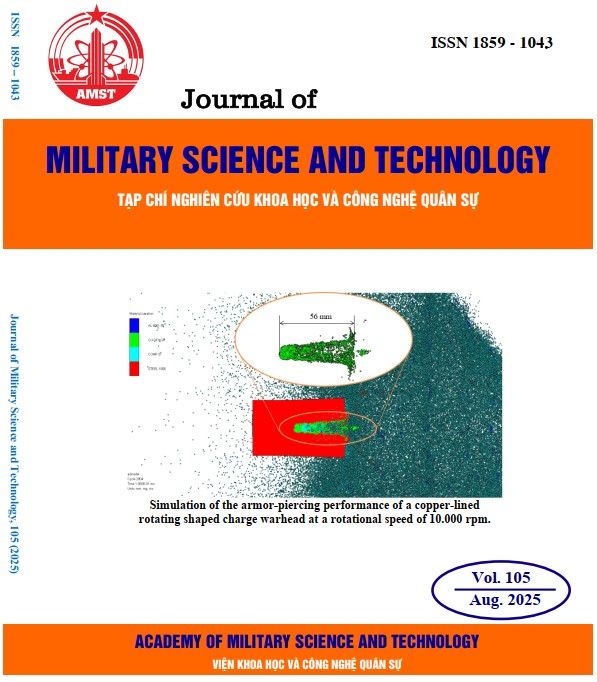Study on the effect of rotating shaped charge liner material on penetration depth using the SPH numerical simulation method
311 viewsDOI:
https://doi.org/10.54939/1859-1043.j.mst.105.2025.163-170Keywords:
40 mm rotating shaped charge warhead; Penetration capability of shaped charge warheads; SPH method.Abstract
In this paper, the effect of liner material on the penetration capability of rotating shaped charge warheads was investigated. The authors employed 3D simulations using the Smoothed Particle Hydrodynamics (SPH) mesh-free method in Ansys Autodyn to study the influence of liner materials on rotating shaped charge warheads. The subject of study is a 40 mm caliber shaped charge warhead, with two liner material options: copper and steel. The numerical simulations were conducted at different rotational speeds about the warhead’s axis of symmetry: non-rotating, 2000 rpm, 4000 rpm, 6000 rpm, 8000 rpm, 10000 rpm, 12000 rpm, and 14000 rpm. The simulation results indicate that as rotational speed increases, the penetration depth into steel decreases. Copper liners exhibit superior steel penetration compared to steel liners. However, when the rotational speed reaches 10000 rpm, the penetration depth of the copper-lined warhead is not significantly greater than that of the steel-lined warhead. This research method can be applied to optimize the structural design of rotating shaped charge warheads.
References
[1]. ANSYS, Inc. “ANSYS Workbench User’s Guide”, (2011).
[2]. A.V. Babkin, S.S. Rassokha, S.V. Ladov, “Calculation method for functionality of the rotating shaped charges”. Oboronnaya tekhnika, no. 1-2, pp. 23-30, (2010) (in Russian).
[3]. A.S. Steshin, A.V. Babkin, “Design Technique for Calculating Functional Parameters of a Rotating Shaped Charge with Preliminary Heated Liner”. Вестник МГТУ им. Н.Э. Баумана. Сер. Естественные науки, ISSN: 1812-3368, № 1, pp. 61-70, (2020). DOI: https://doi.org/10.18698/1812-3368-2020-1-61-70
[4]. Dobratz B.M & CrawfordP.C. UCRL-52997 Rev. “LLNL Explosives Handbook”, (1985).
[5]. K. Naeem, A. Hussain, S. Abbas, “A Review of Shaped Charge Variables for its Optimum Performance”. Engineering, Technology & Applied Science ResearchVol. 9, No. 6, 4917-4924, (2019). DOI: https://doi.org/10.48084/etasr.3153
[6]. L.B. Lucy. "A numerical approach to the testing of the fission hypothesis". Astron. J. 82: 1013–1024. Bibcode:1977AJ.82.1013L. doi:10.1086/112164, (1977). DOI: https://doi.org/10.1086/112164
[7]. L.D. Libersky; A.G. Petschek; A.G. Carney; T.C. Hipp; J.R. Allahdadi; F.A. High. "Strain Lagrangian hydrodynamics: a three-dimensional SPH code for dynamic material response". J. Comput. Phys. 109 (1): 67–75, (1993). doi:10.1006/jcph.1993.1199. DOI: https://doi.org/10.1006/jcph.1993.1199
[8]. R.A. Gingold; J.J. Monaghan. "Smoothed particle hydrodynamics: theory and application to non-spherical stars". Mon. Not. R. Astron. Soc. 181 (3): 375–89, (1977). doi:10.1093/mnras/181.3.375. DOI: https://doi.org/10.1093/mnras/181.3.375
[9]. S.S. Rassokha. “Numerical Simulation of Jet Formation from a Rotating Shaped Charge”. Combust Explos Shock Waves 60, pp. 811-818, (2024). DOI: https://doi.org/10.1134/S0010508224060145
[10]. V. Minh Do, M. Thai Le, X. Son Bui, H. Nguyen Pham and P. Linh Nguyen, “Influence of Wave Shaper Position on Jet Formation and Penetration Depth”, Advances in Military Technology, 15(2), pp. 355-364, (2020), DOI 10.3849/aimt.01385 DOI: https://doi.org/10.3849/aimt.01385
[11]. V. V. Silvestrov, N. N. Gorshkov, “Effect of strain rate on the tensile strength of copper shaped charge jet”. Proceedings of the conference of the American Physical Society topical group on shock compression of condensed matter. AIP Conference Proceedings, Volume 370, pp. 1233-1236, (1996). DOI: https://doi.org/10.1063/1.50704
[12]. A.А. Плющ, “Физические основы устройства ракетно-артиллерийского вооружения. Боеприпасы”, Пензенский артиллерийский инженерный институт, (2014).
[13]. I.B. Mинин, O.B. Mинин, “Кумулятивные заряды”, Сибирская государственная геодезическая академия, (2013).







